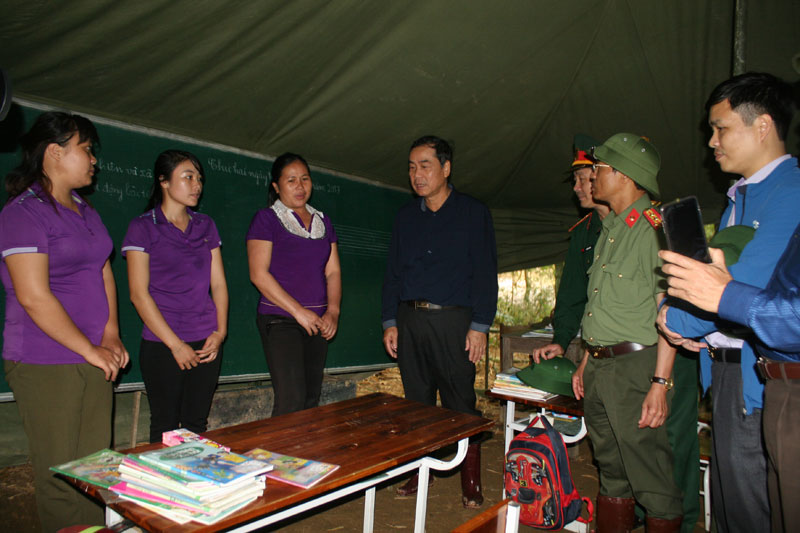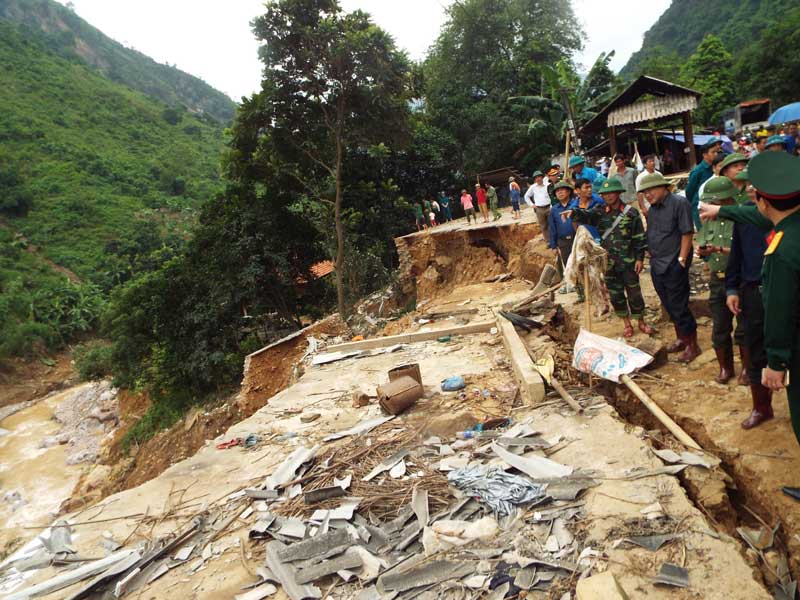
(HBO) – Chairman of the People's Committee of Hoa Binh province Nguyen Van Quang on October 16 inspected and directed efforts to overcome flood aftermaths in Coi 2 hamlet of Suoi Nanh commune and Nhap hamlet of Dong Ruong commune of Da Bac district.
He was accompanied by leaders of provincial police,
military high command, departments of natural resources and environment,
labour, invalids and social affairs, agriculture and rural development,
information and communications, and provincial people’s committee office.
The devastated floods last week killed six people and
left five others missing and nine injured in Da Bac. The floods, causing
landslides, have destroyed hundreds of houses, forcing dozens of families
living in temporary homes. Local infrastructure, including transportation,
irrigation, electricity and telecommunication, has suffered severe damage. Many
inter-communal roads were shut down, leaving several communes isolated. So that
recovery efforts to affected people have faced many difficulties.
The district estimated that about 345 households are
living in high-risk areas, requiring urgent evacuation to safer places. Coi 2 hamlet
of Suoi Nanh commune was hard hit where 10 houses were fully destroyed and over
70 others need to be relocated. The floods closed road No. 433 leading to the
commune so help had to come to the commune by waterway. In Nhap hamlet, 25
affected families have to live temporarily on boats, their lives faced many
difficulties.
State
agencies, organisations and authorities of Da Bac district sent delegations to address
the situation, provide support to flood-hit communes and move at-risk people to
safer places.

Chairman of the provincial People's Committee Nguyen
Van Quang visits Coi 2 hamlet of Suoi Nanh commne to direct efforts to overcome
flood consequences.

Chairman of the provincial People's Committee Nguyen
Van Quang visits pre-school and primary school teachers who had to move to temporary
homes, in Dong Ruong commune.

A house was fully destroyed by floods at Co 2 hamlet,
Suoi Nanh commune.
Quang asked
authorities of Da Bac district to closely coordinate with relevant departments
to assess landslide risks and deploy measures to ensure safety for people here.
At first, the communes must actively evacuate people from high-risk areas to
safe places, or at the offices, schools and communal health stations; help
people losing homes by allowing them to share roof with others; and provide
them with timely support to overcome difficulties and return to normal life.
The Standing Board of the Hoa Binh provincial Party Committee has agreed in principle on a proposal by the Standing Board of the Party Committee of Hoa Binh city to gather feedback on the city’s 1:2000 zoning plan, which forms part of its broader urban development strategy.
Hoa Binh province has made notable progress in public administration reform and digital government development, with the satisfaction index among citizens and businesses reaching over 84%, according to recent government evaluations.
Thanks to great efforts by local authorities in recent times, the governance and public administration performance of Mai Chau district has been significantly improved.
In the afternoon of June 6, the Party Committee, the People's Council, the People's Committee and the Fatherland Front of Lac Son district solemnly held a meeting to celebrate the 139th anniversary of the district's founding (1886–2025) and the 79th anniversary of the establishment of the district's Party Committee (1946–2025). There was the attendance of Mr. Bui Van Thang, the Vice Chairman of the Provincial People's Council; Mr. Quach Tat Liem, the Vice Chairman of the Provincial People's Committee; Ms. Dang Bich Ngoc, the Deputy Head of the National Assembly Delegation of the province; as well as the former leaders of the province and district through various periods, who are the natives of the district.
Implementing the Politburo’s Resolution No. 57-NQ/TW on breakthroughs in science – technology, innovation, and digital transformation is a golden opportunity for the northern mountainous province of Hoa Binh to renew growth model, improve competitive edge and shorten digital gap.
Resolution 57-NQ/TW, issued by the Politburo on December 22, 2024, identifies sci-tech, innovation, and digital transformation as strategic breakthroughs to build a developed and prosperous nation. In Hoa Binh province, this spirit is not just a slogan, it’s being put into action through concrete initiatives that form a "new development triangle”: digital citizenship, digital economy, and digital administration.





